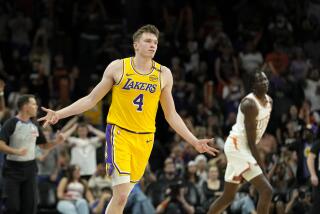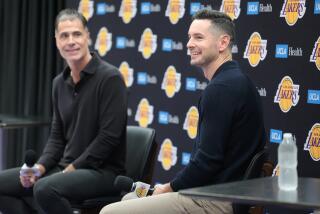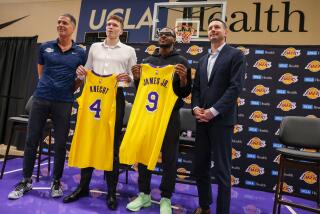Bumper Rookie Crop Suggests the NBA’s Future Is Bright
The names provided the color. Their exploits, though now part of the background, added texture. And their gifts, from jumpers to jams, strength to speed, sharpened what might have been the first rough sketch of the National Basketball Assn.’s future.
By the time the last meeting room cleared and the final tape machine fell still, the 1992 draft-day tote board looked more like a canvas, an abstract painting by numbers and names that presented a glimpse down the road and beyond the travels of Magic Johnson, Larry Bird and Michael Jordan. Almost to a man, general managers, scouts and personnel directors had seen the gathering storm of talent and now, midway through the 1992-93 season, it’s raining players.
Underclassmen such as Shaquille O’Neal, who had been the subject of NBA eyes since just after high school, tipped early projections of last summer’s draft from good to great. O’Neal’s presence alone meant players such as Alonzo Mourning, his attitude and approach already hardened and honed by hours of play opposite Patrick Ewing, and Christian Laettner, among the most celebrated college players in NCAA history, would move on down the line.
But it wasn’t until all the names came in, from Jim Jackson to Harold Miner, that an unusually solid senior class was bolstered by another group of unusually talented youngsters. With the possible exception of a pure point guard, the first 15 picks covered the spectrum of necessary NBA talents.
There were shooters, scorers, big men, small forwards, big guards and centers, and all them possessed a measure of dash. Players such as Mourning, who has been fearless and driven, screamed for non-traditional comparisons. And he is not alone. O’Neal is a monstrous presence and only 20 years old. Walt Williams, the Sacramento Kings’ 6-foot-6 swingman, might be the most dynamic scorer of the group. The Washington Bullets’ Tom Gugliotta is a 6-10, 240-pound package who runs the break and shoots three-pointers.
They arrived with nicknames--Shaq, Zo, Googs, Spoon and Baby Jordan--but have balanced the style with substance. From the beginning and for the moment at least, there have been few retreats and no apologies. When the Detroit Pistons’ cement-skulled Bill Laimbeer pushed too hard, Mourning fired back without hesitation. So much for rookie lessons.
“We thought it was going to be good,” says the Chicago Bulls’ Jerry Krause, who has been working NBA drafts for 30 years. “We felt it was a very deep draft. We knew that going in when we got the hardship list.
“It was very deep. One of the deepest of all time, and you’ve got to remember, two of them aren’t even playing, (Doug) Christie and Jackson. They’re both good players.”
Through three months of its first season, the once fuzzy portrait of the Class of ’92 has become significantly more clear. So too has another patch of road leading beyond the twilight of Jordan’s career. As if by executive order, the planets appear to have lined up in favor of David Stern’s league, and the future, always sunny, seems a little more bright. In the very season Johnson and Bird departed, perhaps the richest and most marketable rookie class in almost a decade has marched in to soften the transition.
O’Neal and Mourning might be the best two centers to arrive in the same season since Bob Lanier and Dave Cowens in 1970. And statistically, O’Neal and Mourning could have significantly better rookie seasons than either of those Hall of Famers. Add Laettner, and the trio might stand alone as the greatest rookie big men to arrive in the NBA at the same time. But the true measure of this group will no doubt be its depth. Players such as the Denver Nuggets’ LaPhonso Ellis, Gugliotta, Williams, the Philadelphia 76ers’ Clarence Weatherspoon, the Houston Rockets’ Robert Horry, the Los Angeles Lakers’ Anthony Peeler, the Phoenix Suns’ Oliver Miller and the Golden State Warriors’ Latrell Sprewell have made significant contributions from the opening tap.
Others such as the Milwaukee Bucks’ Todd Day and Lee Mayberry, the Atlanta Hawks’ Adam Keefe, the Miami Heats’ Miner, the Indiana Pacers’ Malik Sealy and the Dallas Mavericks’ Sean Rooks have shown flashes of long-term employment, if not immediate success.
The rookie class has been so good that even coaches and general managers, a fraternity usually given to caution, have been heard to utter the names of Chamberlain, Russell, Robertson, Barkley and Bird when asked for comparisons. Though some of the comments have bordered on the absurd given history and the absence of any for these rookies--one Dallas executive, whose name will be spared for the sake of embarrassment, compared the unsigned and unknown Jackson to Oscar Robertson--the excitement is genuine.
“I don’t think there is any question that they have really made an impact,” Minnesota Timberwolves general manager Jack McCloskey says. “I think some of these rookies are fortunate that they have gone to teams that have given them an opportunity to play. I mean everyone is talking about the top three, but then you have Ellis, Gugliotta, Williams, Day, who is coming on now, Weatherspoon, Horry. They are all pretty good players.
“Some of those aren’t getting a lot of playing time, but that’s only because of the teams they are with. And then there are some very, very good players who eventually will be excellent players in this league, guys like Sealy, Keefe, Miner and Peeler. They’re good players.
“I think this group compares somewhere in the area (of the 1984 draft). You can’t compare anybody with Michael or maybe (Hakeem) Olajuwon, but eventually O’Neal and Mourning might be comparable to Olajuwon.”
Although an unusual number of rookies have landed in situations geared toward their own development, it’s what they have done with the opportunity that sets them apart. O’Neal and Mourning have turned their teams into playoff contenders; Williams has helped lift Sacramento; Weatherspoon gets rave reviews from 76ers Coach Doug Moe, long known for his disdain for rookies; Horry and Sprewell became instant starters for playoff-quality teams; and Peeler, whose feel for the game appears to match his ability, has had an impact on the Lakers.
“As far as the number of players having an instant impact on the league--and that’s how you have to look at it--this is the best,” Cleveland Cavaliers general manager Wayne Embry says.
Across the board, O’Neal could finish with the best numbers of any NBA rookie center since Kareem Abdul-Jabbar. Not even David Robinson, who was four years older than O’Neal when he arrived, blocked as many shots or grabbed as many rebounds. Beyond that, none of the big three--Robinson, Olajuwon or Ewing--captured the imagination of so many so quickly as O’Neal. Indeed, no player since Jordan has come close to causing the kind of commotion on and off the court that now shadows O’Neal, who is the first rookie voted to start in the All-Star Game since Jordan.
And yet Mourning has been only a step behind. Despite missing all of training camp, Mourning already has established himself as a defensive force. He too blocks shots and rebounds, and he might have an even better shooting touch than O’Neal. Take O’Neal off the board, and the spotlight turns to Mourning.
“Were it not for Shaquille,” Philadelphia general manager Jim Lynam says, “a lot of rave reviews, notices and attention would instead be directed toward Mourning. You’re talking about a rookie who’s going to be in the vicinity of 20 (points) and 10 (rebounds), and he is a defensive presence in his own right.”
Although he hasn’t affected the Timberwolves as some expected, including himself, Laettner clearly is the team’s best player. In a different year, he too would have been a prototypical top choice. As it is, Laettner leads the team in rebounds, gets to the line more than veterans Chuck Person and Doug West and has averaged nearly 18 points per game.
But that’s only the beginning of a long list of major contributors. Ellis has averaged about 14 points and almost nine rebounds per game; Gugliotta, whose all-around game and size caused New York Knicks Coach Pat Riley to compare him with Larry Bird, hit the Utah Jazz for 39 points and 15 rebounds. Williams scored 40 in one night; and Weatherspoon has averaged a solid more than 14 points and seven rebounds playing only 30 minutes a game.
Last year, seven first-round picks averaged 10 or more points and only two--Larry Johnson and Dikembe Mutombo--scored as many as 15 a game. Players such as Doug Smith, the No. 6 pick by Dallas, Luc Longley, No. 7 by Minnesota, and Mark Macon, No. 8 by Denver, might never come close to the contributions of Gugliotta, Williams and Day, the sixth, seventh and eighth selections of 1992.
Equally telling is that the No. 4 pick, Jackson, hasn’t played a minute (he refuses to sign with Dallas). Take Mutombo, the No. 4 man in 1991, out of last season’s group and the talent level drops significantly. Two others, No. 17 Doug Christie and No. 13 Bryant Stith have had contract and injury problems, respectively.
Even then the class is deeper than it looked on draft day. Milwaukee’s Anthony Avent, the San Antonio Spurs’ Lloyd Daniels and Phoenix’s Richard Dumas, all of whom have been outstanding in stretches, also are in their first season. Avent and Dumas were 1991 picks; Avent went to Europe, and Dumas was suspended from the NBA for failing a random preseason drug test. Daniels signed as a free agent. Avent immediately took over a starting forward spot, and Dumas, upon returning from rehabilitation, quickly displaced Cedric Ceballos alongside Charles Barkley.
“I think in terms of depth I have not seen a deeper draft,” Denver general manager Bernie Bickerstaff says. “A lot of people are going to be satisfied. Whether they drafted for need, had a gut feeling about somebody or felt that somebody just fit into their program, you weren’t going to be wrong unless you passed up Shaquille.
“There are a lot of guys who will be in the league a long time. They have a very big upside. But you still appreciate what Bird, Magic and Jordan have done. And there still isn’t anybody who actually carries everybody on his back like those guys did.”
“I felt it went to about (No.) 16, then there were some good players who could make it,” Indiana Pacers president Donnie Walsh says. “I mean since I’ve been doing it, this is the best draft I’ve seen. I think Shaquille, Mourning and Laettner are only going to get better. Ellis is really good. I think he’ll have a solid 10 years in this league. Gugliotta and Williams will only get better, and those two have the potential to be stars.
“Williams not only has the offensive skills, but he’s a lot bigger than people think. He goes about 235 pounds, and he’s closer to 6-9. He’s big, and he can play any position. That makes him extremely valuable, and he’s capable of scoring big numbers inside or out. The kid in Philadelphia (Weatherspoon) is a good player, and his future should be great. He’s like a mini Barkley. Todd Day is starting to play well, and our guy, Sealy, is going to be very good. So it’s very deep. Then you have Sprewell and Jon Barry, who I also think will be good.”
More to Read
All things Lakers, all the time.
Get all the Lakers news you need in Dan Woike's weekly newsletter.
You may occasionally receive promotional content from the Los Angeles Times.







